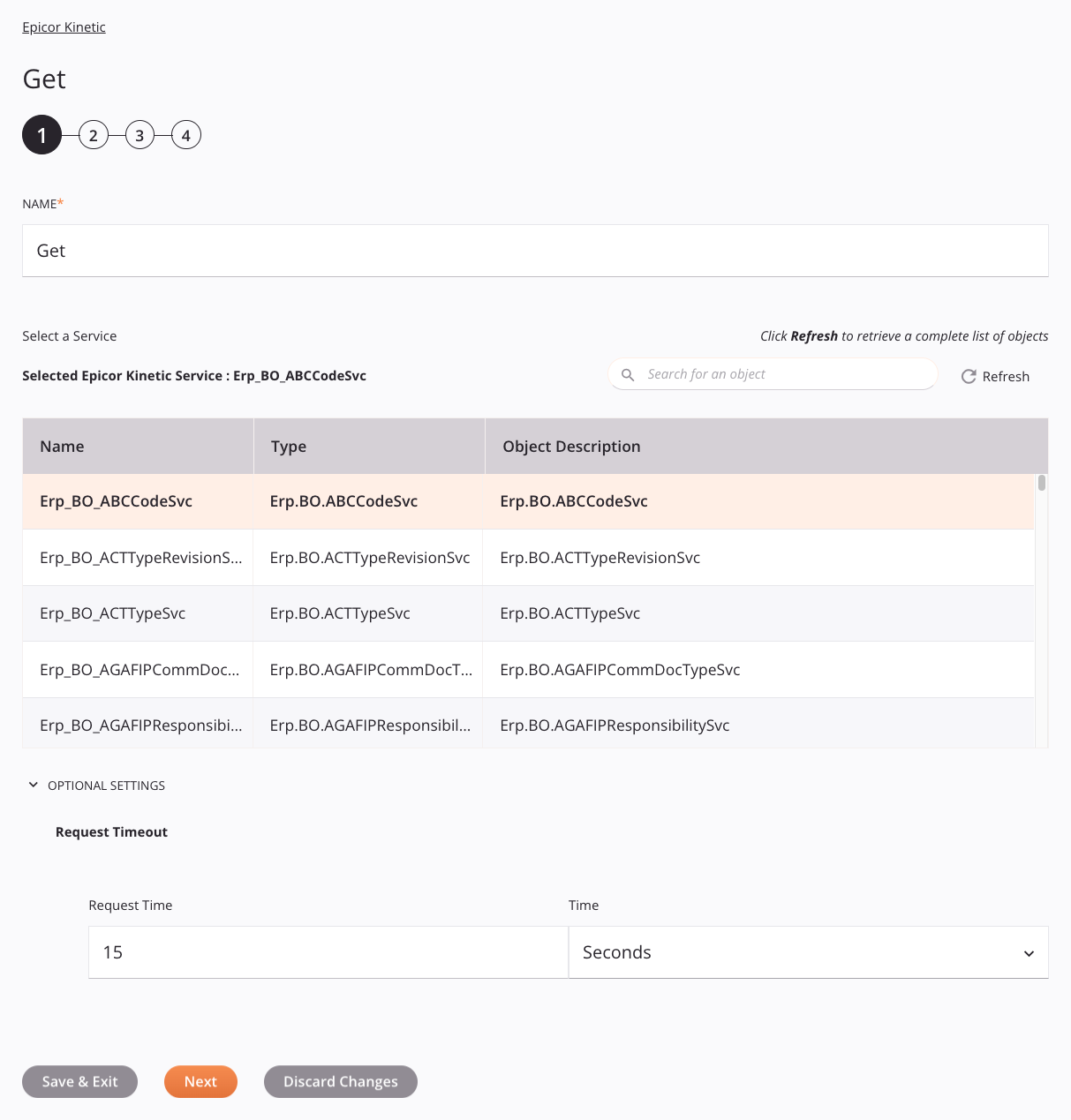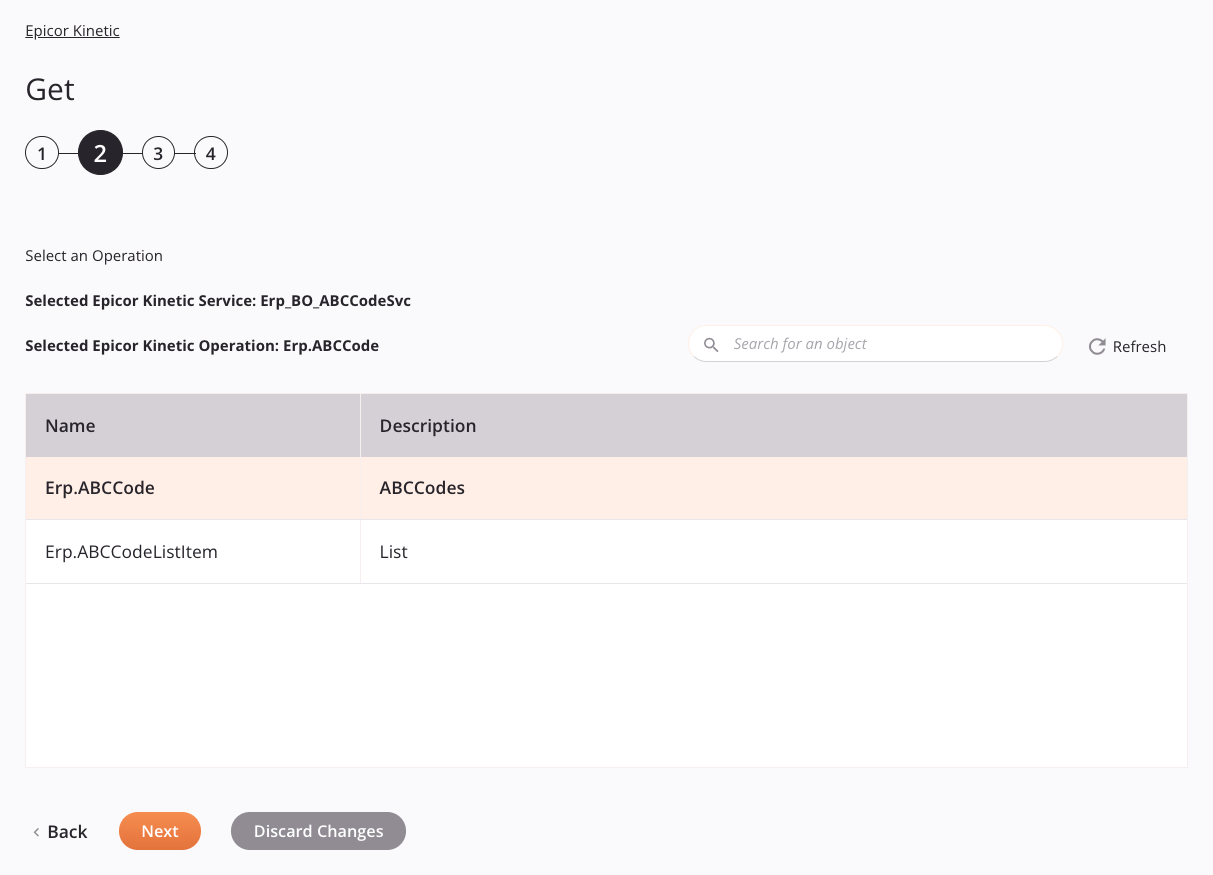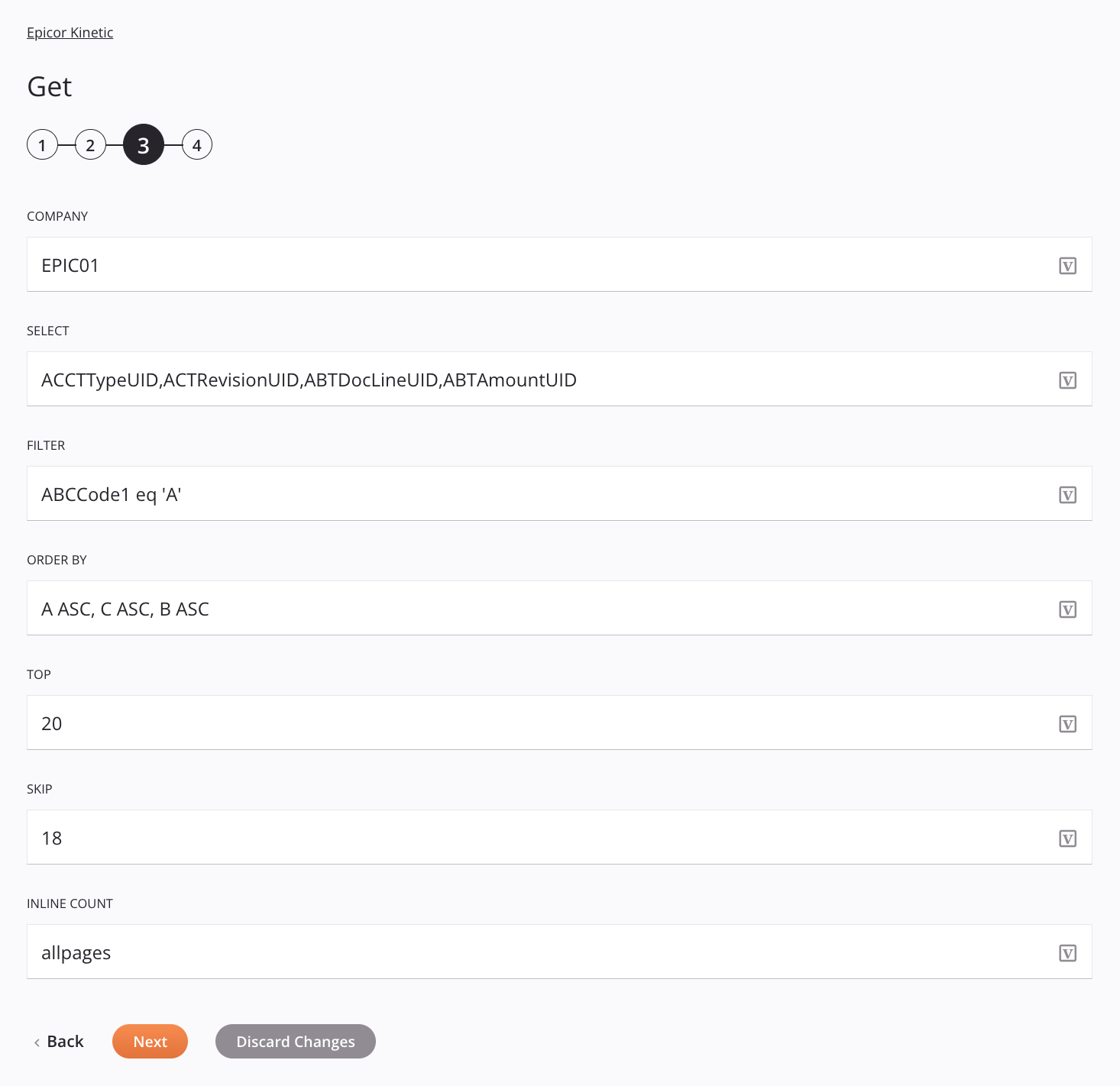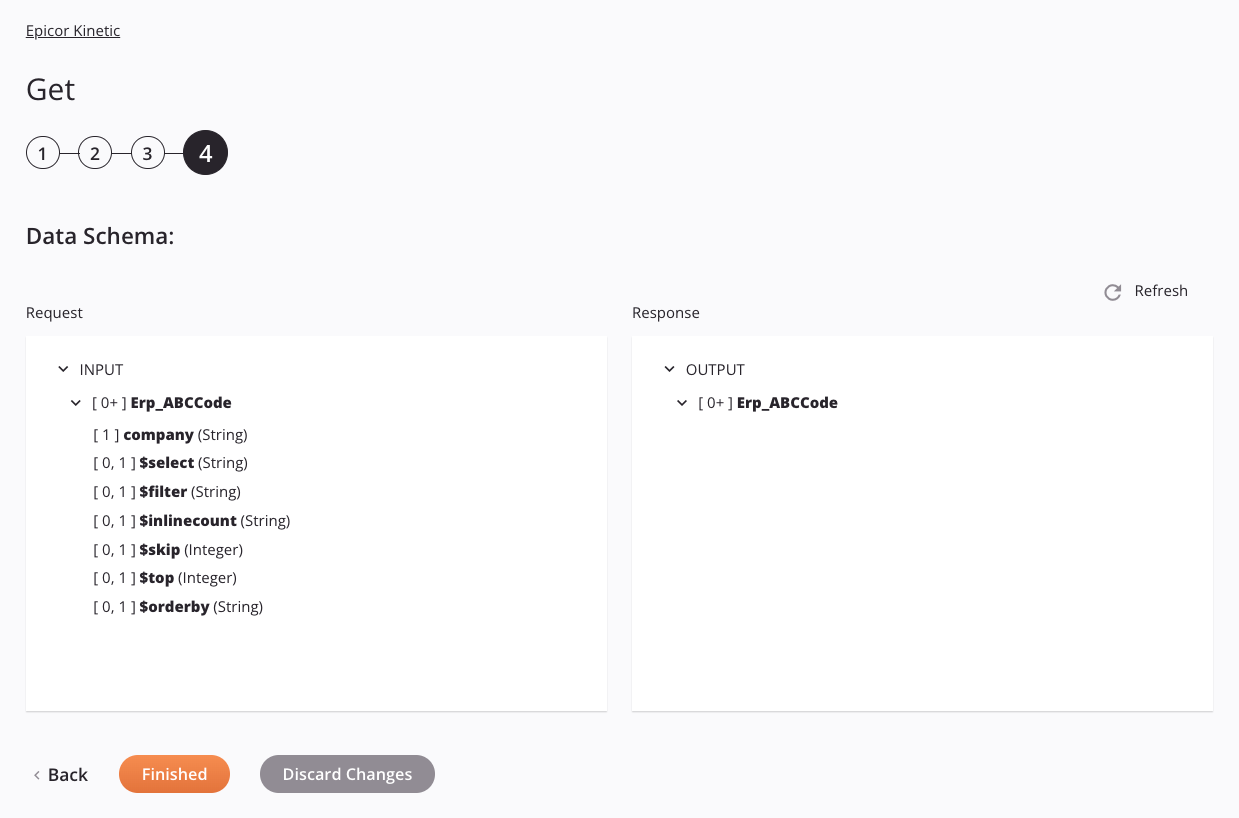Epicor Kinetic Get activity¶
Introduction¶
An Epicor Kinetic Get activity, using its Epicor Kinetic connection, retrieves object data from Epicor Kinetic and is intended to be used as a source to provide data in an operation.
See also the Epicor Kinetic Get BAQ activity, which retrieves data using a BAQ (Business Activity Query).
Create an Epicor Kinetic Get activity¶
An instance of an Epicor Kinetic Get activity is created from an Epicor Kinetic connection using its Get activity type.
To create an instance of an activity, drag the activity type to the design canvas or copy the activity type and paste it on the design canvas. For details, see Create an activity instance in Component reuse.
An existing Epicor Kinetic Get activity can be edited from these locations:
- The design canvas (see Component actions menu in Design canvas).
- The project pane's Components tab (see Component actions menu in Project pane Components tab).
Configure an Epicor Kinetic Get activity¶
Follow these steps to configure an Epicor Kinetic Get activity:
-
Step 1: Enter a name and select a service
Provide a name for the activity and select a service. -
Step 2: Select an operation
Select an operation. -
Step 3: Specify settings
Specify OData system query options. -
Step 4: Review the data schemas
Any request or response schemas are displayed.
Step 1: Enter a name and select a service¶
In this step, provide a name for the activity and select a service. Each user interface element of this step is described below.

-
Name: Enter a name to identify the activity. The name must be unique for each Epicor Kinetic Get activity and must not contain forward slashes
/or colons:. -
Select a Service: This section displays services available in the Epicor Kinetic endpoint.
-
Selected Epicor Kinetic Service: After a service is selected, it is listed here.
-
Search: Enter any column's value into the search box to filter the list of services. The search is not case-sensitive. If services are already displayed within the table, the table results are filtered in real time with each keystroke. To reload services from the endpoint when searching, enter search criteria and then refresh, as described below.
-
Refresh: Click the refresh icon
 or the word Refresh to reload services from the Epicor Kinetic endpoint. This may be useful if services have been added to Epicor Kinetic. This action refreshes all metadata used to build the table of services displayed in the configuration.
or the word Refresh to reload services from the Epicor Kinetic endpoint. This may be useful if services have been added to Epicor Kinetic. This action refreshes all metadata used to build the table of services displayed in the configuration. -
Selecting a Service: Within the table, click anywhere on a row to select a service. Only one service can be selected. The information available for each service is fetched from the Epicor Kinetic endpoint:
-
Name: The name of the service.
-
Type: The type of the service.
-
Object Description: The description of the service.
-
Tip
If the table does not populate with available services, the Epicor Kinetic connection may not be successful. Ensure you are connected by reopening the connection and retesting the credentials.
-
-
Optional Settings: Click to expand an additional optional setting:
-
Request Timeout: Specify the timeout for the request (the default is 15 seconds):
-
Request Time: Enter the numerical value to be used for the timeout (in milliseconds or seconds, depending on the unit of Time selected).
-
Time: The unit of time for the request timeout, either Milliseconds or Seconds.
Note
This setting will override the Request Timeout configured in the Epicor Kinetic connection.
-
-
-
Save & Exit: If enabled, click to save the configuration for this step and close the activity configuration.
-
Next: Click to temporarily store the configuration for this step and continue to the next step. The configuration will not be saved until you click the Finished button on the last step.
-
Discard Changes: After making changes, click to close the configuration without saving changes made to any step. A message asks you to confirm that you want to discard changes.
Step 2: Select an operation¶
In this step, select an operation. Each user interface element of this step is described below.

-
Select an Operation: This section displays operations available in the Epicor Kinetic endpoint.
-
Selected Epicor Kinetic Service: The service selected in the previous step is listed here.
-
Selected Epicor Kinetic Operation: After an operation is selected, it is listed here.
-
Search: Enter any column's value into the search box to filter the list of operations. The search is not case-sensitive. If operations are already displayed within the table, the table results are filtered in real time with each keystroke. To reload operations from the endpoint when searching, enter search criteria and then refresh, as described below.
-
Refresh: Click the refresh icon
 or the word Refresh to reload operations from the Epicor Kinetic endpoint. This may be useful if operations have been added to Epicor Kinetic. This action refreshes all metadata used to build the table of operations displayed in the configuration.
or the word Refresh to reload operations from the Epicor Kinetic endpoint. This may be useful if operations have been added to Epicor Kinetic. This action refreshes all metadata used to build the table of operations displayed in the configuration. -
Selecting an Operation: Within the table, click anywhere on a row to select an operation. Only one operation can be selected. The information available for each operation is fetched from the Epicor Kinetic endpoint:
-
Name: The name of the operation.
-
Description: The description of the operation.
-
Tip
If the table does not populate with available operations, the Epicor Kinetic connection may not be successful. Ensure you are connected by reopening the connection and retesting the credentials.
-
-
Back: Click to temporarily store the configuration for this step and return to the previous step.
-
Next: Click to temporarily store the configuration for this step and continue to the next step. The configuration will not be saved until you click the Finished button on the last step.
-
Discard Changes: After making changes, click to close the configuration without saving changes made to any step. A message asks you to confirm that you want to discard changes.
Step 3: Specify settings¶
In this step, optionally specify OData system query options. Each user interface element of this step is described below.

Tip
Fields with a variable icon ![]() support using global variables, project variables, and Jitterbit variables. Begin either by typing an open square bracket
support using global variables, project variables, and Jitterbit variables. Begin either by typing an open square bracket [ into the field or by clicking the variable icon to display a list of the existing variables to choose from.
-
Company: Enter the company code. For example,
EPIC01. -
Select: Specify an OData select system query option as a comma-delimited list of fields.
-
Filter: Specify an OData filter system query option to filter results.
-
Order By: Specify an OData orderby system query option to sort results.
-
Top: Specify an OData top system query option of the number of results to be included.
-
Skip: Specify an OData skip system query option of the number of results to be skipped.
-
Inline Count: Specify an OData count system query option to request a count of the matching resources included with the resources in the response.
-
Back: Click to temporarily store the configuration for this step and return to the previous step.
-
Next: Click to temporarily store the configuration for this step and continue to the next step. The configuration will not be saved until you click the Finished button on the last step.
-
Discard Changes: After making changes, click to close the configuration without saving changes made to any step. A message asks you to confirm that you want to discard changes.
Step 4: Review the data schemas¶
Any request or response schemas are displayed. Each user interface element of this step is described below.

-
Data Schemas: These data schemas are inherited by adjacent transformations and are displayed again during transformation mapping.
Note
Data supplied in a transformation takes precedence over the activity configuration.
The Epicor Kinetic connector uses the Epicor REST API, available in a Swagger UI from
https://<epicor-host-name>/Server/api/help/. Epicor REST Services version 1 is supported. Epicor REST Services version 2 is not supported. Refer to the API documentation for information on the schema fields. (A login to Epicor is required; substitute your Epicor host name in the above URL.)The Get activity supports both JSON and XML its request and response schemas.
-
Refresh: Click the refresh icon
 or the word Refresh to regenerate schemas from the Epicor Kinetic endpoint. This action also regenerates a schema in other locations throughout the project where the same schema is referenced, such as in an adjacent transformation.
or the word Refresh to regenerate schemas from the Epicor Kinetic endpoint. This action also regenerates a schema in other locations throughout the project where the same schema is referenced, such as in an adjacent transformation. -
Back: Click to temporarily store the configuration for this step and return to the previous step.
-
Finished: Click to save the configuration for all steps and close the activity configuration.
-
Discard Changes: After making changes, click to close the configuration without saving changes made to any step. A message asks you to confirm that you want to discard changes.
Next steps¶
After configuring an Epicor Kinetic Get activity, complete the configuration of the operation by adding and configuring other activities, transformations, or scripts as operation steps. You can also configure the operation settings, which include the ability to chain operations together that are in the same or different workflows.
Menu actions for an activity are accessible from the project pane and the design canvas. For details, see Activity actions menu in Connector basics.
Epicor Kinetic Get activities can be used as a source with these operation patterns:
- Transformation pattern
- Two-target archive pattern (as the first source only)
- Two-target HTTP archive pattern (as the first source only)
- Two-transformation pattern (as the first or second source)
To use the activity with scripting functions, write the data to a temporary location and then use that temporary location in the scripting function.
When ready, deploy and run the operation and validate behavior by checking the operation logs.